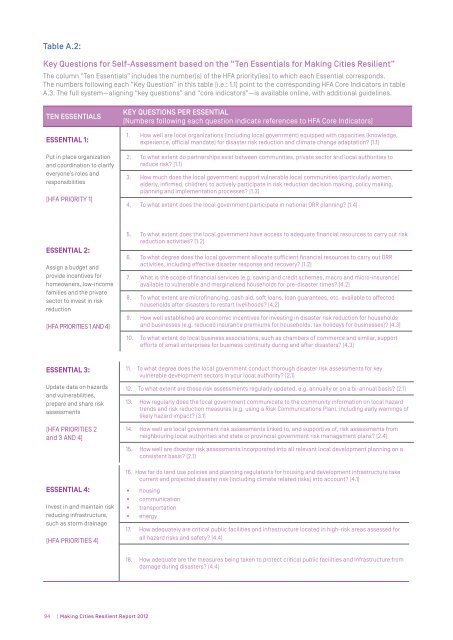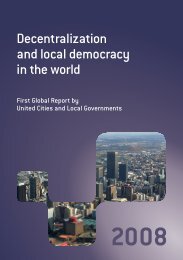Making Cities Resilient Report 2012
Making Cities Resilient Report 2012
Making Cities Resilient Report 2012
Create successful ePaper yourself
Turn your PDF publications into a flip-book with our unique Google optimized e-Paper software.
Table A.2:<br />
Key Questions for Self-Assessment based on the “Ten Essentials for <strong>Making</strong> <strong>Cities</strong> <strong>Resilient</strong>”<br />
The column “Ten Essentials” includes the number(s) of the HFA priority(ies) to which each Essential corresponds.<br />
The numbers following each “Key Question” in this table [i.e.: 1.1] point to the corresponding HFA Core Indicators in table<br />
A.3. The full system—aligning “key questions” and “core indicators”—is available online, with additional guidelines.<br />
TEN ESSENTIALS<br />
ESSENTIAL 1:<br />
Put in place organization<br />
and coordination to clarify<br />
everyone’s roles and<br />
responsibilities<br />
[HFA PRIORITY 1]<br />
KEY QUESTIONS PER ESSENTIAL<br />
[Numbers following each question indicate references to HFA Core Indicators]<br />
1. How well are local organizations (including local government) equipped with capacities (knowledge,<br />
experience, official mandate) for disaster risk reduction and climate change adaptation [1.1]<br />
2. To what extent do partnerships exist between communities, private sector and local authorities to<br />
reduce risk [1.1]<br />
3. How much does the local government support vulnerable local communities (particularly women,<br />
elderly, infirmed, children) to actively participate in risk reduction decision making, policy making,<br />
planning and implementation processes [1.3]<br />
4. To what extent does the local government participate in national DRR planning [1.4]<br />
ESSENTIAL 2:<br />
Assign a budget and<br />
provide incentives for<br />
homeowners, low-income<br />
families and the private<br />
sector to invest in risk<br />
reduction<br />
[HFA PRIORITIES 1 AND 4]<br />
5. To what extent does the local government have access to adequate financial resources to carry out risk<br />
reduction activities [1.2]<br />
6. To what degree does the local government allocate sufficient financial resources to carry out DRR<br />
activities, including effective disaster response and recovery [1.2]<br />
7. What is the scope of financial services (e.g. saving and credit schemes, macro and micro-insurance)<br />
available to vulnerable and marginalised households for pre-disaster times [4.2]<br />
8. To what extent are microfinancing, cash aid, soft loans, loan guarantees, etc. available to affected<br />
households after disasters to restart livelihoods [4.2]<br />
9. How well established are economic incentives for investing in disaster risk reduction for households<br />
and businesses (e.g. reduced insurance premiums for households, tax holidays for businesses) [4.3]<br />
10. To what extent do local business associations, such as chambers of commerce and similar, support<br />
efforts of small enterprises for business continuity during and after disasters [4.3]<br />
ESSENTIAL 3:<br />
Update data on hazards<br />
and vulnerabilities,<br />
prepare and share risk<br />
assessments<br />
[HFA PRIORITIES 2<br />
and 3 AND 4]<br />
ESSENTIAL 4:<br />
Invest in and maintain risk<br />
reducing infrastructure,<br />
such as storm drainage<br />
[HFA PRIORITIES 4]<br />
11. To what degree does the local government conduct thorough disaster risk assessments for key<br />
vulnerable development sectors in your local authority [2.1]<br />
12. To what extent are these risk assessments regularly updated, e.g. annually or on a bi-annual basis [2.1]<br />
13. How regularly does the local government communicate to the community information on local hazard<br />
trends and risk reduction measures (e.g. using a Risk Communications Plan), including early warnings of<br />
likely hazard impact [3.1]<br />
14. How well are local government risk assessments linked to, and supportive of, risk assessments from<br />
neighbouring local authorities and state or provincial government risk management plans [2.4]<br />
15. How well are disaster risk assessments incorporated into all relevant local development planning on a<br />
consistent basis [2.1]<br />
16. How far do land use policies and planning regulations for housing and development infrastructure take<br />
current and projected disaster risk (including climate related risks) into account [4.1]<br />
• housing<br />
• communication<br />
• transportation<br />
• energy<br />
17. How adequately are critical public facilities and infrastructure located in high-risk areas assessed for<br />
all hazard risks and safety [4.4]<br />
18. How adequate are the measures being taken to protect critical public facilities and infrastructure from<br />
damage during disasters [4.4]<br />
94 | <strong>Making</strong> <strong>Cities</strong> <strong>Resilient</strong> <strong>Report</strong> <strong>2012</strong>

















